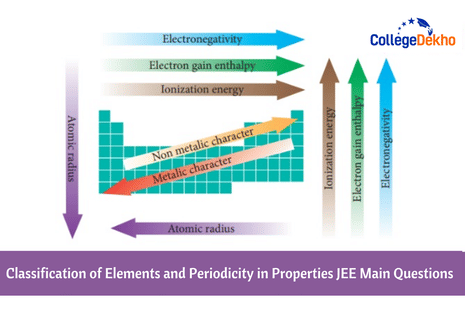The Classification of Elements and Periodicity in Properties in the JEE Main 2026 syllabus carries the weightage of around 9%. It is one of the important chapters in the Chemistry syllabus of the JEE Main exam. The important questions have been provided here

Classification of Elements and Periodicity in Properties JEE Main Questions 2026:
The Chemistry Paper for the JEE Main 2026 exam might carry 3-4 questions from the chapter Classification of Elements and Periodicity in Properties. The applicants need to cover every chapter in the chemistry syllabus of the exam. It will help them fetch better scores in the exam. The important chapters in the unit classification of elements and periodicity in properties are the modern periodic law and the present form of the periodic table. Practice the previous year and important questions for this chapter here, and evaluate your performance for the
JEE Main 2026 Exam
. Aspirants must note that according to the official schedule, JEE Mains 2026 will be held from January 21, 2026, to January 30, 2026.
Check Also:
JEE Main Previous Year Question Paper
JEE Main 2026 Classification of Elements and Periodicity in Properties Important Questions
- Which of the following elements have half-filled f-orbitals in their ground state? (Given : atomic number Sm = 62; Eu = 63; Tb = 65; Gd = 64, Pm = 61 ). Choose the correct answer from the options listed below.
- B and D only
- A and E only
- A and B only
- C and D only
Correct Answer: A
- The element with the largest electronegativity is?
- Lithium
- Sodium
- Fluorine
- Chlorine
Correct Answer: C
3. What is the correct order of increasing ionization energy for Na, Mg, and Al?
- Na < Mg < Al
- Al < Mg < Na
- Mg < Na < Al
- Mg < Al < Na
Correct Answer: A
4. Which of the following statements is correct regarding nonmetals?
- They are good conductors of heat
- They are ductile
- They are brittle
- They are lustrous
Correct Answer: C
5. Which element has the highest metallic character?
- Magnesium
- Calcium
- Strontium
- Barium
Correct Answer: D
6. Which of the following elements has the smallest atomic radius?
- Lithium
- Sodium
- Potassium
- Francium
Correct Answer: A
7. What is the trend of atomic radius in the periodic table?
- Increases down a group
- Decreases down a group
- Increases across a period
- Decreases across a period
Correct Answer: A
8. Which of the following represents the correct order of metallic character of the given elements?
- Si < Be < Mg < K
- Be < Si < Mg < K
- K < Mg < Be < Si
- Be < Si < K < Mg
Correct Answer: A
9. Given below are two statements :
Statement (I) : The oxidation state of an element in a particular compound is the charge acquired by its atom on the basis of electron gain enthalpy consideration from other atoms in the molecule.
Statement (II) : pπ−pπ bond formation is more prevalent in second period elements over other periods.
In the light of the above statements, choose the most appropriate answer from the options given below :
- Statement 1 is correct but statement II is incorrect
- Both statement I and II are correct
- Statement I is incorrect but statement II is correct
- Both statements I and II are incorrect
Correct Answer: C
10. Number of elements from the following that CANNOT form compounds with valencies which match with their respective group valencies is ________. B, C, N, S, O, F, P, Al, Si
- 7
- 3
- 5
- 6
Correct Answer: B
11. Following statements regarding the periodic trends of chemical reactivity of the alkali metals and the halogens are given. Which of these statements give the correct picture ?
- The reactivity decreases in the alkali metals but increases in the halogens with increase in atomic number down the group
- In both the alkali metals and the halogens the chemical reactivity decreases with increase in atomic number down the group
- Chemical reactivity increases with increase in atomic number down the group in both the alkali metals and halogens.
- In alkali metals the reactivity increases but in the halogens it decreases with increase in atomic number down the group
Correct Answer: D
12. The atomic numbers of vanadium (V), chromium (Cr), manganese (Mn) and iron (Fe) are respectively. 23, 24, 25 and 26. Which one of these may be expected to have the highest second ionization enthalpy ?
- Fe
- V
- Cr
- Mn
Correct Answer: C
13. The increasing order of the first ionization enthalpies of the elements B, P, S and F (lowest first) is
- F < S < P < B
- P < S < B < F
- B < P < S < F
- B < S < P < F
Correct Answer: D
14. The correct order of electron gain enthalpy with negative sign of F, Cl, Br and I, having atomic numbers 9, 17, 35 and 53 respectively, is
- I > Br > Cl > F
- F > Cl > Br > I
- Cl > F > Br > I
- Br > Cl > I > F
Correct Answer: C
15. Which of the following represents the correct order of increasing first ionization enthalpy for Ca, Ba, S, Se and Ar?
- Ca < S < Ba < Se < Ar
- S < Se < Ca < Ba < Ar
- Ba < Ca < Se < S < Ar
- Ca < Ba < S < Se < Ar
Correct answer: C
16. Similarity in chemical properties of the atoms of elements in a group of the Periodic table is most closely related to:
- number of principal energy levels
- number of valence electrons
- atomic numbers
- atomic masses
Correct Answer: B
17. Which of the following represents the correct order of increasing first ionization enthalpy for Ca, Ba, S, Se and Ar?
- S < Se < Ca < Ba < Ar
- Ba < Ca < Se < S < Ar
- Ca < Ba < S < Se < Ar
- Ca < S < Ba < Se < Ar
Correct Answer: B
18. Beryllium and aluminium exhibit many properties which are similar. But the two elements differ in
- exhibiting maximum covalency in compound
- exhibiting amphoteric nature in their oxides
- forming covalent halides
- forming polymeric hydrides
Correct Answer: A
19. The lanthanide contraction is responsible for the fact that
- Y have about the same radius
- Zr and Nb have similar oxidation state
- Zr and Hf have about the same radius
- Zr and Zn have the same oxidation
Correct Answer: C
20. The following statements regarding the periodic trends of chemical reactivity of the alkali metals and the halogens are given. Which of these statements gives the correct picture?
- The reactivity decreases in the alkali metals but increases in the halogens with increase in atomic number down the group
- In both the alkali metals and the halogens the chemical reactivity decreases with increase in atomic number down the group
- Chemical reactivity increases with increase in atomic number down the group in both the alkali metals and halogens
- In alkali metals, the reactivity increases but in the halogens, it decreases with increase in atomic number down the group
Correct Answer: D
21. Iron exhibits +2 and +3 oxidation states. Which of the following statements about iron is incorrect?
- Ferrous oxide is more basic in nature than the ferric oxide
- Ferrous compounds are relatively more ionic than the corresponding ferric compounds
- Ferrous compounds are less volatile than the corresponding ferric compounds
- Ferrous compounds are more easily hydrolysed than the corresponding ferric compounds
Correct Answer: D
Classification of Elements and Periodicity in Properties JEE Main Questions 2026: Important Practice Questions
- Ionization enthalpy of an ion is equal to
- Electron gain enthalpy of the atom
- Electronegativity of the ion
- Ionization enthalpy of the ion
- None of these
- P4 has an exceptional outer electronic configuration as 4d105S0. It belongs to
- 4th period, group 11
- 5th period, group 10
- 6th period, group 9
- 3rd period, group 16
- The IUPAC name of the element with atomic number z = 109 is
- U np
- U ns
- U no
- U ne
- Which of the following is most electropositive?
- Ai
- Mg
- P
- S
- Consider the following statements:
i) The radius of an ion is larger than that of the parent atom
ii) The ionization energy generally increases with increasing atomic number in a period.
iii) The electronegativity of an element is the tendency of an isolated atom to attract an electron.
Which of the above-given statements is correct?
- I alone
- II alone
- I and II alone
- II and III
- Which of the following sets belong to that of alkali metals?
- 1, 12, 30, 4, 62
- 37, 19, 3, 55
- 9, 17, 35, 53
- 12, 20, 56, 88
- Element with the atomic number 56 belongs to which block?
- S
- P
- D
- F
- According to the periodic law of elements, the variation in properties of elements is related to
- Nuclear masses
- Atomic numbers
- Nuclear neutron-proton number ratio
- Atomic masses
- Which of the following remains unchanged on descending a group in the periodic table?
- Valence electrons
- Atomic size
- Density
- Metallic character
- Which of the following has the least electron affinity?
- Oxygen
- Argon
- Nitrogen
- Boron
- The incorrect statement among the following is:
- The first ionization potential of AI is less than the first ionization potential of Mg
- The second ionization potential of Mg is greater than the second ionization potential of Na
- The first ionization potential of Na is less than the first ionization potential of Mg
- The third ionization potential of Mg is greater than the third ionization potential of AI
- The second ionization potential of an element M is the energy required to Correct the statement for the periodic classification of the element is:
- Remove one mole of electrons from one mole of gaseous cations of the element
- Remove one mole of electrons from one mole of gaseous anions
- Remove one mole of electrons from one mole of monovalent gaseous cations of the elements
- Remove 2 moles of electrons from one mole of gaseous atoms
The correct statement for the periodic classification of elements is:
- All lanthanides and actinides belong to group IIIB
- All inert gases end at p6 configuration
- Iron, Cobalt and Nickel have same density so they are classed in VIIIB group together
- There are 12 naturally occurring radioactive elements in the periodic table
False statement for periodic classification of element is
- The properties of the elements are periodic functions of their atomic numbers.
- No. of non-metallic elements is less than the no. of metallic elements
- First ionization energy of elements does not change continuously with increasing atomic no. in a period.
- d-subshell is filled by a final electron with increasing atomic no. of inner transition elements.
- Mode of hybridization effects
- ‘s’ character of a bond pair electron
- ‘s’ and ‘p’ character of a bond pair
- None of these
- Odd electron
- Among the NaF, NaCl, NaBr, and Nal, NaF has the highest melting point because
- It has maximum ionic character
- It has minimum ionic characters
- It has associated molecules
- It has the least molecular weight
- For the formation of covalent bonds, the difference in the value of electronegativities should be
- Equal to or less than 1.7
- More than 1.7
- 1.7 or more
- None
- For a p-block element, its 3d, 3s, 3p, and 4s orbitals are completely filled and the differentiating electron goes to the 4p orbital. The element should have its atomic number in the range
- 13-18
- 21-26
- 31-36
- 49-54
- The atomic number of the element unnilennium is
- 109
- 102
- 108
- 119
- The elements with atomic numbers 101 and 104 belong to, respectively:
- Group 11 and Group 4
- Actinoids and Group 6
- Actinoids and Group 4
- Group 6 and actinoids
Related Articles
We hope this article has been helpful to be aware of the Classification of Elements and Periodicity in Properties JEE Main Questions 2026 along with their solutions. Stay tuned to Collegedekho for the latest updates on JEE Mains 2026.
Are you feeling lost and unsure about what career path to take after completing 12th standard?
Say goodbye to confusion and hello to a bright future!

FAQs
The JEE Main exam incorporates various question types, comprising multiple-choice questions (MCQs), numerical value-based questions, as well as drawing-based questions. With MCQs, candidates must select the correct answer from the given options.
No. The JEE Mains exam alone is not enough for securing admission into an IIT. JEE Advanced is the crucial examination required for IIT admissions, and candidates are required to qualify in the JEE Main exam to be eligible for the JEE Advanced exam.
Yes, 90 is considered to be a good percentile in the JEE Main 2025 entrance exam. Candidates can secure admission into NITs, IITs or IISc Bangalore if they score a rank between 1,00,000 and 1,50,000 with a 90 percentile in the JEE Main exam.
Mathematics is often considered to be the most challenging subject in the JEE Main exam, but its difficulty level varies from person to person. Some students may find other subjects more challenging based upon their strengths and weaknesses.
NCERT books are very important to prepare for the JEE Main 2025 exam. The JEE Main exam follows the CBSE syllabus for 11th and 12th classes, so NCERT books are considered to be the most reliable and necessary study materials. NCERT books explain basic fundamental concepts in a simple and clear way.
To score a 99+ percentile in the JEE Main 2025 exam, candidates require more than just knowing the JEE Main syllabus, as it required consistent practice, strategic revision, time management, and the ability to solve complex problems under pressure. However, with the appropriate resources, one can achieve these requirements.
All sections namely Mathematics, Physics, and Chemistry are mandatory in the JEE Main exam, with questions covering the entire JEE Main syllabus. To be eligible for admission, candidates must achieve the minimum qualifying marks in each subject and the overall aggregate.
Candidates can study from the NCERT textbooks of class 11 and 12 Physics, Chemistry and Mathematics to cover the JEE Mains syllabus. No changes have been made to the JEE Main Syllabus 2025. NTA removed several topics of Physics, Chemistry and Mathematics last year from the JEE Main syllabus.
Candidates must keep in mind that there is no requirement of 75% marks in class 12 for appearing in the JEE Mains exam. The JEE Main eligibility criteria of minimum 75% marks in class 12 is required at the time of securing admission across NITs, IIITs and GFTIs. Candidates can apply and appear in the JEE Mains 2025 exam irrespective of their class 12 marks.
Previous year question papers are an important source for the JEE Main preparations. However, relying solely upon PYQs is not enough to fully prepare for the JEE Mains exam. Candidates must also focus on covering the entire syllabus, developing strong conceptual understanding, practising time management, and attempting mock tests.
Was this article helpful?





















Similar Articles
GATE CS Question Paper Difficulty Level Trends: A detailed analysis
JEE Main 2026 Chemistry High Priority and Low Priority Chapters
Are JEE Main Study Groups Worth It? Detailed Pros and Cons for 2026 Aspirants
How to Prioritize Physics Chapters Based on JEE Main 2026 Weightage and Difficulty
GATE 2026 Mechanical Engineering Expected No. of Questions Topic-Wise
GATE 2026 Civil Engineering Expected No. of Questions Topic-Wise